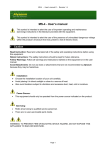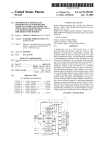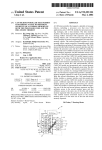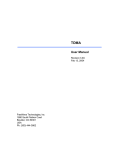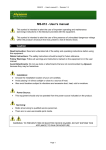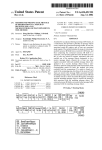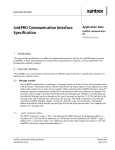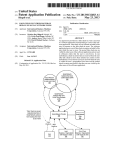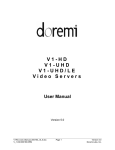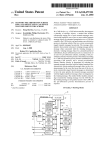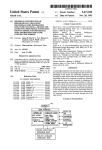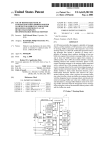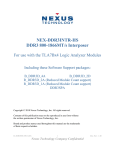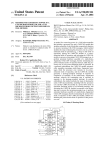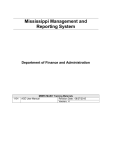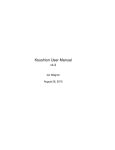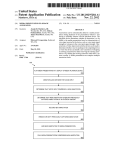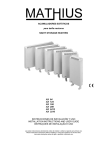Download Semaphore coding method to ensure data integrity in a can
Transcript
US006631431B1 (12) United States Patent (10) Patent N0.: Silvkoff et al. (54) US 6,631,431 B1 (45) Date of Patent: Oct. 7, 2003 SEMAPHORE CODING METHOD TO ENSURE DATA INTEGRITY IN A CAN MICROCONTROLLER ANDACAN OTHER PUBLICATIONS National Semiconductor Corp. : “8—bit CMOS ROM based microcontroller With 2k memory, comparators and CAN MICROCONTROLLER THAT IMPLEMENTS interface” Internet, ’Online! Sep. 1, 1999 p. 21—p. 29. THIS METHOD . . * cited by examiner (75) Inventors: William J. Silvko?', San Jose, CA (US); Neil E. BlI‘IlS, Cupertino, CA Primary Examiner—Paul R. Myers (57) ABSTRACT (US); Peter Hank, Halstenbek (DE); Mathius Muth, Stelle (DE) A method for use in a CAN device (e.g., a CAN microcontroller) that includes a processor core and hardWare (73) Assigneer Kollillklijke Philips Electronics N-V-, external to the processor core (e.g., a DMA engine) that EiHdhOVeIl (NL) Writes message data into a designated message buffer for Subject to any disclaimer> the term of this nated message buffer. The method includes providing a ensuring integrity of the message data stored in the desig (*) Notice? Patent is extended or adjusted under 35 three-state semaphore to indicate a current access status of U-S-C- 154(k)) byo days- the designated message buffer, the three-state semaphore having a ?rst state indicative of the hardWare external to the (21) Appl. No.: 09/474,903 (22) Filed: processor core starting to Write neW message data into the designated message buffer, a second state indicative of the hardWare external to the processor core having ?nished Writing the neW message data into the designated message buffer, and, a third state indicative of the processor core Dec. 30, 1999 Related U S Application Data (60) Provisional application NO‘ 60/154,022’ ?led on SeP' 15’ 1999 starting to read message data from'the designated message buffer. The processor core determines Whether the desig nated message buffer is ready to be accessed based on the current state of the semaphore. The processor core, after determining that the designated message buffer is ready to be accessed, reads the message data from the designated mes Sage buffer- After the Processor eere has ?nished reading the (51) Int. Cl.7 .............................................. .. G06F 13/00 (52) US. Cl. ...................................... .. 710/100; 710/308 (58) Field of Search ........................ .. 710/100 22 308- the Current State of the Semaphore ‘0 determine Whether it 709/223, 250, 229; 370/245, 901, 908 has changed to a different state during the time that the message data from the designated message buffer, it checks processor core Was reading the message data from the designated message buffer. If the processor core determines (56) References Cited that the current state of the semaphore changed during the time that the processor core Was reading the message data U'S' PATENT DOCUMENTS 4,658,351 A * 5,179,665 A * 5,434,975 A * 5,574,848 A 11/1996 Thomson 5,901,070 A * 5,946,471 A * 6,122,713 A * from the designated message buffer, it again determines 4/1987 Teng ........................ .. 709/103 1/1993 Roslund et a1, 709/215 7/1995 Allen ......... .. 709/107 -- 395/181 5/1999 Trainor ........... .. 700/298 8/1999 Voorhees et a1. . 703/23 9/2000 Huang et a1. ............. .. 711/147 Whether the designated message buffer is ready to be accessed, based on the current state of the semaphore. After again determining that the designated message buffer is ready to be accessed, the processor core again reads the message data from the designated message buffer_ 28 Claims, 7 Drawing Sheets U.S. Patent 0a. 7, 2003 Sheet 3 0f 7 US 6,631,431 B1 MMRS MMR name I RM? 1 Reset IAccess lAddress Ollset lDescription Message Object Registers [n = O - 31) MnMlDH MnMlDL MnMSKH MnMSKL MnClL R/W R/W R/W R/W R/W x....xOOb xxxxh x....xOOOb xxxxh OOOOOxxxb Word only Word only Wordonly Word only Byte/Word OO0n4n3n2n1ngOOOOb(nOh) OOOn4n3n2n1ngOOlOb(n2h) OOOn4n3n2n1ng0t00bttl4hl OO0n4n3ngn1ngOllObln6h) OO0n4n3n2n1ng10OOb(n8h) MnBLR MnBSZ R/W R/W xxxxh Word only OUUUOXXXO Byte/Word OOOn4n3n2n1ngi0lOb (nAh) MessagenBullerLocation OOOn4n3n2n1ngtlOOb(nCh) MessagenBuiter Size MnFCR R/W OOXXXXXXO Byte/Word OOOn4n3n2n1ng1llOb(nEh) MessagenFragmentationCounl ClC Registers MCPLL R/C OOOOh Byte/Word 221th MCPLH R/C OOOOh Byte/Word 226h Message Complete High CANINTFLG MClR MEIR FESTR FEENR R/C RO RO R/C R/W OOOOh OOOOh OOOOh OOOOh OOOOh Byte/Word Byte/Word Byte/Word Byte/Word Byte/Word 228h 22% 22Ah 22Ch 22Eh CAN interrupt Flag Register Message Complete lnlo Reg. Message Error lnlo Register Frame Error Status Register Frame Error Enable Register SCP/SPI Conliguration SCP/SPI Data SCP/SPl Control and Status SPlCFG R/W OOOOh SCP/SPl Registers Byte/Word 260h SPIOATA SPICS R/W R/W OOh OOh Byte/Word Byte/Word 262h 263h MessagenMatohlOHigh MessagenMatohlDLow MessagenMaskHigh MessagenMaskLow MessagenConlrol Message Complete Low CCB Registers CANCMR CANSTR W R/O 0th OOh Byte/Word Byte/Word 270R 27th CAN Command Register CAN Status Register CANBlR RAN 00h Byte/Word 272h CAN Bus liming Reg. (low) TXERC R/W B/W* 00h OOh Byte/Word Byte/Word 273h 274h CAN Bus liming Reg. (high) ix Error Counter RXERC EWLR ECCR ALCR RTXDTM GCTL R/W* R/W RO R0 WO R/W OOh 96h OOOOh OOOOh OOOOh OOOOh Byte/Word 275h Byte/Word 27Gb Byte/Word 278h Byte/Word 27Ah Byte/Word 27Ch Byte/Word 27Eh MlF Registers RxError Counter Error Warning Limit Register Error Code Capture Register Arbitration Lost Capture Reg. RTX Data lest Mode Global Control Byte XRAMB R/W FEh Byte/Word 290h XRAM Base Address MBXSR R/W FFh Byte/Word 29th Msg. Bull/XRAM Seg. Reg. MIFBTRL R/W EFh Byte/Word 292h MlF Bus Timing Reg, Low MlFBlRH R/W FFh Byte/Word 293h MlF Bus Timing Reg. High Legend: R/W = Read & Write, R0 = Read Only, WO = Write Only, R/C = Read & Clear, W* = writable only during G 4 CAN Reset mode, x = undelined alter reset. - U.S. Patent 0a. 7, 2003 Sheet 4 0f 7 US 6,631,431 B1 Data Memory Segment 0 OOFFFFh .LLLLLLLI Off-Chip 4K Bytes MMR Space r'fTTTTf-l- MMR Base Address Off-Chip 512 BytesT XRAMFITI'ITIT XRAM Base Address Off-Chip 0003FFh _LLLLJ_!_LJ Off-Chip Data Memory (Scratch Pad) FTTHTIT‘ OOOOOOh MMR Space Offset FFFh —-—> Offset 1 FFh --—> 512 Bytes Object Registers <—~ Offset OOOh FIG. 6 U.S. Patent 0a. 7, 2003 Sheet 5 0f 7 US 6,631,431 B1 Segment xy in Data Memory Space xyFFFFh _______t Object HT Object n Message Butter 323 315 315 e23 e16 a15 30 XRAM 512 Bytes t—— 4- MBXSR[7:0] a8 a7 XRAMBUIHO at] 00h I—'_ xyOOOOh Segment xy in Data Memory Space xyFFFFh _—I 2123 a16 a15 <— MBXSRUzO] at] MnBLR Obiecm‘t Object n Message Buffer XRAM 512 Bytes Butter size | )(RAM 323 316 a15 a8 a7 ,_—<_ MBXSR[7:0] XRAMB[7:1]0|| 00h I—_ xyOOOOh FIG. 8 at) U.S. Patent 0a. 7, 2003 Sheet 6 6f 7 US 6,631,431 B1 Object n Match lD Field (MnMlDH and MnMlDL) Mid28 — Midi8 Midi? — MidiO Mid9 — Mid2 Midi MidO MIDE Object n Mask Field (MnMSKH and MnMSKL) Msk28 — Mski8 Mskl 7 — MskiO MskQ — Msk2 Mskl MskO Screener ID Field (assembled from incoming bit-stream) CAN ID.28— CAN |D.18 Data Bytei [7:0] Data Byte2 [7:0] x x IDE MidO MIDE Object n Match ID Field (MnMlDH and MnMlDL) Mid28 — Midi8 Midi? — MidiO Mid9 — Mid2 Midi Object n Mask Field (MnMSKH and MnMSKL) Msk28 — Msk18 Mski 7 — Mskil) Msk9 — Msk2 Mski MskO Screener ID Field (assembled from incoming bit-stream) CAN lD.28 - CAN ID.O FIG. 10 IDE U.S. Patent 0a. 7, 2003 Sheet 7 0f 7 US 6,631,431 B1 8W") Rt‘ééét‘é)? Data Byte 2 Data Byte 3 ADDRESS Data Byte DLC Data Byte 2 (next) Data Byte 3 (next) FIG. 11 Framelnto Data Byte 1 DataByte2 Data Byte DLC Frarnelnto (next) Data Byte 1 (next) Data Byte 2 (next) FIG. 12 DIRECTION OF INCREASING ADDRESS US 6,631,431 B1 1 2 SEMAPHORE CODING METHOD TO ENSURE DATA INTEGRITY IN A CAN MICROCONTROLLER AND A CAN MICROCONTROLLER THAT IMPLEMENTS THIS METHOD member of the Philips XA (eXtended Architecture) family of high performance 16-bit single-chip microcontrollers. It is believed that the XA-C3 is the ?rst chip that features hardWare CAL support. The XA-C3 is a CMOS 16-bit CAL/CAN 2.0B micro controller that incorporates a number of different inventions, including the present invention. These inventions include This application claims the full bene?t and priority of US. Provisional Application Ser. No. 60/154,022, ?led on Sep. 15, 1999, the disclosure of Which is fully incorporated novel techniques and hardWare for ?ltering, buffering, handling, and processing CAL/CAN messages, including herein for all purposes. the automatic assembly of multi-frame fragmented mes sages With minimal CPU intervention, as Well as for man BACKGROUND OF THE INVENTION The present invention relates generally to the ?eld of data communications, and more particularly, to the ?eld of serial communications bus controllers and microcontrollers that incorporate the same. aging the storage and retrieval of the message data, and the memory resources utiliZed therefor. 15 CAN (Control Area Network) is an industry-standard, The present invention relates to a method for Writing a three-state semaphore code to a given message buffer to indicate an access status of the given message buffer. The application (softWare) running on the CPU can then read this three-state semaphore code to determine Whether the given message buffer is ready for the CPU to read, Whether the tWo-Wire serial communications bus that is Widely used in automotive and industrial control applications, as Well as in medical devices, avionics, office automation equipment, given message buffer is presently being accessed by the consumer appliances, and many other products and appli DMA engine (and therefore is not ready for the CPU to read), or Whether the given message buffer is presently being read by the CPU. In this manner, the integrity of the data stored in the given message buffer is ensured, even if the cations. CAN controllers are currently available either as stand-alone devices adapted to interface With a microcon troller or as circuitry integrated into or modules embedded in a microcontroller chip. Since 1986, CAN users (softWare 25 programmers) have developed numerous high-level CAN DMA engine accesses the given message buffer While a CPU read is in progress. Application Layers (CALs) Which extend the capabilities of SUMMARY OF THE INVENTION the CAN While employing the CAN physical layer and the CAN frame format, and adhering to the CAN speci?cation. CALs have heretofore been implemented primarily in softWare, With very little hardWare CAL support. Consequently, CALs have heretofore required a great deal of The present invention encompasses a method for use in a CAN device (e.g., a CAN microcontroller) that includes a processor core and hardWare external to the processor core (e.g., a DMA engine) that Writes message data into a host CPU intervention, thereby increasing the processing overhead and diminishing the performance of the host CPU. designated message buffer for ensuring integrity of the Thus, there is a need in the art for a CAN hardWare message data stored in the designated message buffer. The method includes providing a three-state semaphore to indi implementation of CAL functions normally implemented in cate a current access status of the designated message buffer, 35 softWare in order to offload these tasks from the host CPU the three-state semaphore having a ?rst state indicative of to the CAN hardWare, thereby enabling a great savings in the hardWare external to the processor core starting to Write neW message data into the designated message buffer, a second state indicative of the hardWare external to the processor core having ?nished Writing the neW message data host CPU processing resources and a commensurate improvement in host CPU performance. One of the most demanding and CPU resource-intensive CAL functions is message management, Which entails the handling, storage, and processing of incoming CAL/CAN messages received over the CAN serial communications bus and/or outgoing 45 into the designated message buffer, and, a third state indica tive of the processor core starting to read message data from the designated message buffer. The processor core deter CAL/CAN messages transmitted over the CAN serial com mines Whether the designated message buffer is ready to be munications bus. CAL protocols, such as DeviceNet, accessed based on the current state of the semaphore. The processor core, after determining that the designated mes sage buffer is ready to be accessed, reads the message data from the designated message buffer. After the processor core has ?nished reading the message data from the designated message buffer, it checks the current state of the semaphore CANopen, and OSEK, deliver long messages distributed over many CAN frames, Which methodology is sometimes referred to as “fragmented” or “segmented” messaging. The process of assembling such fragmented, multi-frame mes sages has heretofore required a great deal of host CPU intervention. In particular, CAL softWare running on the host CPU actively monitors and manages the buffering and processing of the message data, in order to facilitate the to determine Whether it has changed to a different state during the time that the processor core Was reading the 55 message data from the designated message buffer. If the assembly of the message fragments or segments into com processor core determines that the current state of the plete messages. semaphore changed during the time that the processor core Was reading the message data from the designated message Based on the above and foregoing, it can be appreciated that there presently exists a need in the art for a hardWare buffer, it again determines Whether the designated message implementation of CAL functions normally implemented in buffer is ready to be accessed, based on the current state of softWare in order to offload these tasks from the host CPU, the semaphore. After again determining that the designated thereby enabling a great savings in host CPU processing message buffer is ready to be accessed, the processor core resources and a commensurate improvement in host CPU again reads the message data from the designated message performance. buffer. The assignee of the present invention has recently devel oped a neW microcontroller product, designated “XA-C3”, that ful?lls this need in the art. The XA-C3 is the neWest 65 In a preferred embodiment, the providing step is imple mented by means of the hardWare external to the processor core Writing a ?rst code value corresponding to the ?rst state US 6,631,431 B1 3 4 of the semaphore to a designated storage location When it is starting to Write neW message data into the designated message buffer, and Writing a second code value correspond ing to the second state of the semaphore to the designated storage location When it is ?nished Writing neW message data into the designated message buffer, and the processor core Writing a third code value corresponding to the third state of the semaphore to the designated storage location When it is starting to read message data from the designated message buffer. The designated storage location, in a spe in any desired application, e.g., in a stand-alone CAN controller device or as part of any other microcontroller or system. The folloWing terms used herein in the context of describ ing the preferred embodiment of the present invention (i.e., the XA-C3 microcontroller) are de?ned as folloWs: Standard CAN Frame: The format of a Standard CAN Frame is depicted in FIG. 1. Extended CAN Frame: The format of an Extended CAN 10 ci?c implementation, constitutes prescribed bit positions of the ?rst byte of the designated message buffer. The present invention, in another of its aspects, encom ments in order to determine if a CAN frame should be accepted or ignored and, if accepted, to store that frame in passes a CAN device, e.g., a CAN microcontroller, that implements the above-described method. 15 BRIEF DESCRIPTION OF THE DRAWINGS can be considered to be a communication channel over Which a complete message, or a succession of messages, can be transmitted. CAN Arbitration ID: An 11-bit (Standard CAN 2.0 Frame) or 29-bit (Extended CAN 2.0B Frame) identi?er ?eld 25 FIG. 2 is a diagram illustrating the interleaving of CAN Data Frames of different, unrelated messages; FIG. 3 is a high-level, functional block diagram of the XA-C3 microcontroller; FIG. 4 is a table listing all of the Memory Mapped placed in the CAN Frame Header. This ID ?eld is used to arbitrate Frame access to the CAN bus. Also used in Acceptance Filtering for CAN Frame reception and Transmit Pre-Arbitration. Screener ID: A 30-bit ?eld extracted from the incoming message Which is then used in Acceptance Filtering. The Screener ID includes the CAN Arbitration ID and the IDE bit, and can include up to 2 Data Bytes. These 30 extracted Registers (MMRs) provided by the XA-C3 microcontroller; FIG. 5 is a diagram illustrating the mapping of the overall data memory space of the XA-C3 microcontroller; FIG. 6 is a diagram illustrating the MMR space contained Within the overall data memory space of the XA-C3 micro a pre-assigned Message Object. Message Object: A Receive RAM buffer of pre-speci?ed siZe (up to 256 bytes for CAL messages) and associated With a particular Acceptance Filter or, a Transmit RAM buffer Which the User preloads With all necessary data to transmit a complete CAN Data Frame. A Message Object These and various other aspects, features, and advantages of the present invention Will be readily understood With reference to the folloWing detailed description of the inven tion read in conjunction With the accompanying draWings, in Which: FIG. 1 is a diagram illustrating the format of a Standard CAN Frame and the format of an Extended CAN Frame; Frame is also depicted in FIG. 1. Acceptance Filtering: The process a CAN device imple bits are the information quali?ed by Acceptance Filtering. Match ID: A 30-bit ?eld pre-speci?ed by the user to Which 35 the incoming Screener ID is compared. Individual Match IDs for each of 32 Message Objects are programmed by controller; the user into designated Memory Mapped Registers FIG. 7 is a diagram illustrating formation of the base address of the on-chip XRAM of the XA-C3 microcontroller, With an object n message buffer mapped into off-chip data memory; FIG. 8 is a diagram illustrating formation of the base address of the on-chip XRAM of the XA-C3 microcontroller, With an object n message buffer mapped (MMRs). into the on-chip XRAM; Mask: A 29-bit ?eld pre-speci?ed by the user Which can override (Mask) a Match ID comparison at any particular bit (or, combination of bits) in an Acceptance Filter. Individual Masks, one for each Message Object, are programmed by the user in designated MMRs. Individual Mask patterns assure that single Receive Objects can 45 Mask Fields; FIG. 10 is a diagram illustrating the Screener ID Field for an Extended CAN Frame, and corresponding Match ID and Mask Fields; FIG. 11 is a diagram illustrating the message storage format for fragmented CAL messages; and, FIG. 12 is a diagram illustrating the message storage format for fragmented CAN messages. 55 DETAILED DESCRIPTION OF THE PREFERRED EMBODIMENT The present invention is described beloW in the context of a particular implementation thereof, i.e., in the context of the XA-C3 microcontroller manufactured by Philips Semicon ductors. Of course, it should be clearly understood that the present invention is not limited to this particular implementation, as any one or more of the various aspects 65 and features of the present invention disclosed herein can be utiliZed either individually or any combination thereof, and Screen for multiple acknoWledged CAL/ CAN Frames and thus minimiZe the number of Receive Objects that must be dedicated to such loWer priority Frames. This ability to Mask individual Message Objects is an important neW CAL feature. FIG. 9 is a diagram illustrating the Screener ID Field for a Standard CAN Frame, and corresponding Match ID and CAL: CAN Application Layer. A generic term for any high-level protocol Which extends the capabilities of CAN While employing the CAN physical layer and the CAN frame format, and Which adheres to the CAN speci?ca tion. Among other things, CALs permit transmission of Messages Which exceed the 8 byte data limit inherent to CAN Frames. This is accomplished by dividing each message into multiple packets, With each packet being transmitted as a single CAN Frame consisting of a maxi mum of 8 data bytes. Such messages are commonly referred to as “segmented” or “fragmented” messages. The individual CAN Frames constituting a complete fragmented message are not typically transmitted in a contiguous fashion, but rather, the individual CAN Frames of different, unrelated messages are interleaved on the CAN bus, as is illustrated in FIG. 2 Fragmented Message: A lengthy message (in excess of 8 bytes) divided into data packets and transmitted using a US 6,631,431 B1 6 5 Special Function Register (SFR) bus 43. These stan dard microcontroller peripherals include Universal Asynchronous Receiver Iransmitter (UART) 49, an SPI serial interface (port) 51, three standard timers/ counters With toggle output capability, namely, Timer 0 sequence of individual CAN Frames. The speci?c Ways that sequences of CAN Frames construct these lengthy messages is de?ned Within the context of a speci?c CAL. The XA-C3 microcontroller automatically re-assembles these packets into the original, lengthy message in hard Ware and reports (via an interrupt) When the completed & Timer 1 included in Timer block 53, and Timer 2 included in Timer block 54, a Watchdog Timer 55, and four 8-bit I/O ports, namely, Ports 0—3 included in block 61, each of Which has 4 programmable output (re-assembled) message is available as an associated Receive Message Object. Message Buffer: A block of locations in XA Data memory Where incoming (received) messages are stored or Where 10 Data memory space and is accessed as Data memory by the XAprocessor. With the XA-C3 microcontroller, a set of eight dedicated MMRs are associated With each Mes sage Object. Additionally, there are several MMRs Whose con?gurations. The DMA engine 38, the MMRs 40, and the CCB 42 can collectively be considered to constitute a CAN/ CAL module 77, and Will be referred to as such at various times through outgoing (transmit) messages are staged. MMR: Memory Mapped Register. An on-chip command/ control/status register Whose address is mapped into XA out the folloWing description. Further, the particular logic 15 elements Within the CAN/CAL module 77 that perform “message management” and “message handling” functions Will sometimes be referred to as the “message management bits control global parameters that apply to all Message engine” and the “message handler”, respectively, at various times throughout the folloWing description. Other nomen Objects. With reference noW to FIG. 3, there can be seen a 20 clature Will be de?ned as it introduced throughout the folloWing description. high-level block diagram of the XA-C3 microcontroller 20. The XA-C3 microcontroller 20 includes the folloWing func tional blocks that are fabricated on a single integrated circuit (IC) chip packaged in a 44-pin PLCC or a 44-pin LQFP package: 25 As previously mentioned, the XA-C3 microcontroller 20 automatically implements, in hardWare, many message man agement and other functions that Were previously only implemented in softWare running on the host CPU (or not an XA CPU Core 22, that is currently implemented as a implemented at all), including transparent, automatic 16-bit fully static CPU With 24-bit program and data address range, that is upWardly compatible With the 80C51 architecture, and that has an operating fre quency of up to 30 MHZ; a program or code memory 24 that is currently imple re-assembly of up to 32 concurrent, interleaved, multi frame, fragmented CAL messages. For each application that is installed to run on the host CPU (i.e., the XA CPU Core 30 ones of the MMRs and SFRs in the manner set forth in the mented as a 32 K ROM/EPROM, and that is bi-directionally coupled to the XA CPU Core 22 via an internal Program bus 25. A map of the code memory space is depicted in FIG. 4; a Data RAM 26 (internal or scratch pad data memory) that is currently implemented as a 1024 Byte portion of the overall XA-C3 data memory space, and that is bi-directionally coupled to the XA CPU Core 22 via an internal DATA bus 27; XA-C3 Functional Speci?cation and XA-C3 CAN Transport Layer Controller User Manual. The register programming 35 40 currently implemented as a 512 Byte portion of the Object) message buffers; 45 50 data memory space, as illustrated in FIG. 5. In particular, subject to certain constraints, the user must specify the starting or base address of the XRAM 28 and the starting or base address of the MMRs 40. The base address of the MMRs 40 can be speci?ed by appropriately programming Special Function Registers (SFRs) MRBL and MRBH. The base address of the XRAM 28 can be speci?ed by appro 55 priately programming the MMRs designated MBXSR and XRAMB (see FIG. 4). 60 40 anyWhere Within the entire 16 Mbyte data memory space supported by the XA architecture, other than at the very bottom of the memory space (i.e., the ?rst 1 KByte portion, starting address of 000000h), Where it Would con?ict With The user can place the 4 KByte space reserved for MMRs Pointers and 32 ID Screeners or Match IDs, corre sponding to the 32 CAL Message Objects. A complete listing of all MMRs is provided in the Table depicted in FIG. 5; Set-up/Programming Procedures As an initial matter, the user must map the overall XA-C3 a plurality of on-chip Memory Mapped Registers (MMRs) 40 that are mapped to the overall XA-C3 data memory space—a 4 K Byte portion of the overall XA-C3 data memory space is reserved for MMRs. These MMRs include 32 (Message) Object or Address description of the various message management and other functions that are automatically performed by the CAL/ CAN module 77 during operation of the XA-C3 microcon troller 20 after it has been properly set-up by the user. provided. a Memory Interface (MIF) unit 30 that provides interfaces to generic memory devices such as SRAM, DRAM, ?ash, ROM, and EPROM memory devices via an external address/data bus 32, via an internal Core Data bus 34, and via an internal MMR bus 36; a DMA engine 38 that provides 32 CAL DMA Channels; procedures that are most relevant to an understanding of the present invention are described beloW, folloWed by a FolloWing these sections, a more detailed description of the particular invention to Which this application is directed is an on-chip message buffer RAM or XRAM 28 that is overall XA-C3 data memory space Which may contain part or all of the CAN/CAL (Transmit & Receive 22), the user (softWare programmer) must set-up the hard Ware for performing these functions by programming certain the on-chip Data RAM 26 that serves as the internal or a 2.0B CAN/DLL Core 42 that is the CAN Controller scratch-pad memory. The 4 KBytes of MMR space Will Core from the Philips SJA 1000 CAN (2.0A/B) Data Link Layer (CDLL) device (hereinafter referred to as an array of standard microcontroller peripherals that are alWays start at a 4 K boundary. The reset values for MRBH and MRBL are 0Fh and F0h, respectively. Therefore, after a reset, the MMR space is mapped to the uppermost 4 K Bytes of Data Segment 0Fh, but access to the MMRs 40 is bi-directionally coupled to the XA CPU Core 22 via a disabled. The ?rst 512 Bytes (offset 000h—1FFh) of MMR the “CAN Core Block” (CCB)); and, 65 US 6,631,431 B1 7 8 space are the Message Object Registers (eight per Message Filtering, on an object-by-object basis, by Writing a logic ‘1’ in the desired (to-be-masked) bit position(s) in the appro priate MnMSKH and/or MnMSKL registers associated With each particular Message Object n. The user is responsible, Object) for objects n=0—31, as is shown in FIG. 6. The base address of the XRAM 28 is determined by the contents of the MMRs designated MBXSR and XRAMB, as is shoWn in FIGS. 7 and 8. As previously mentioned, the 512 Byte XRAM 28 is Where some (or all) of the 32 (Rx/Tx) message buffers (corresponding to Message Objects on set-up, for assigning a unique message buffer location for each Message Object n. In particular, the user can specify the least signi?cant 16 bits of the base address of the message n=0—31) reside. The message buffers can be extended off buffer for each particular Message Object n by programming chip to a maximum of 8 KBytes. This off-chip expansion capability can accommodate up to thirty-tWo, 256-Byte the MnBLR register associated With that Message Object n. The upper 8 bits of the 24-bit address, for all Message Objects, are speci?ed by the contents of the MBXSR register, as previously discussed, so that the message buffers for all Message Objects reside Within the same 64 KByte message buffers. Since the uppermost 8 bits of all message buffer addresses are formed by the contents of the MBXSR register, the XRAM 28 and all 32 message buffers must reside in the same 64 K Byte data memory segment. Since the XA-C3 microcontroller 20 only provides address lines A0—A19 for accessing external memory, all external memory segment. The user is also responsible, on set-up, for 15 specifying the siZe of the message buffer for each Message Object n. In particular, the user can specify the siZe of the memory addresses must be Within the loWest 1MByte of address space. Therefore, if there is external memory in the system into Which any of the 32 message buffers Will be mapped, then all 32 message buffers and the XRAM 28 must also be mapped entirely into that same 64 K Byte segment, Which must be beloW the 1MByte address limit. message buffer for each particular Message Object n by programming the MNBSZ register associated With that After the memory space has been mapped, the user can The user can con?gure (program) the MnCTL register associated With each particular Message Object n in order to enable or disable that Message Object n, in order to de?ne Message Object n. The top location of the message buffer for each Message Object n is determined by the siZe of that message buffer as speci?ed in the corresponding MNBSZ register. set-up or de?ne up to 32 separate Message Objects, each of Which can be either a Transmit (TX) or a Receive (Rx) 25 or designate that Message Object n as a Tx or Rx Message Object; in order to enable or disable automatic hardWare Message Object. A Rx Message Object can be associated either With a unique CAN ID, or With a set of CAN IDs assembly of fragmented Rx messages (i.e., automatic frag Which share certain ID bit ?elds. As previously mentioned, each Message Object has its oWn reserved block of data memory space (up to 256 Bytes), Which is referred to as that Message Object’s message buffer. As Will be seen, both the siZe and the base address of each Message Object’s message mented message handling) for that Message Object n; in order to enable or disable automatic generation of a Message-Complete Interrupt for that Message Object n; and, in order to enable or not enable that Message Object n for Remote Transmit Request (RTR) handling. In CANopen and buffer is programmable. As previously mentioned, each Message Object is asso ciated With a set of eight MMRs 40 dedicated to that OSEK systems, the user must also initialiZe the MnFCR 35 register associated With each Message Object n. As previously mentioned, on set-up, the user must con Message Object. Some of these registers function differently for TX Message Objects than they do for Rx Message Objects. These eight MMRs 40 are designated “Message ?gure (program) the global GCTL register, Whose bits control global parameters that apply to all Message Objects. In particular, the user can con?gure (program) the GCTL Object Registers” (see FIG. 4). register in order to specify the high-level CAL protocol (if any) being used (e.g., DeviceNet, CANopen, or OSEK); in The names of these eight MMRs 40 are: order to enable or disable automatic acknoWledgment of CANopen Frames (CANopen auto-acknowledge); and, in 1. MnMIDH Message n Match ID High 2. MnMIDL Message n Match ID LoW 45 order to specify Which of tWo transmit (Tx) pre-arbitration schemes/policies is to be utiliZed (i.e., either Tx pre arbitration based on CAN ID, With the object number being 3. MnMSKH Message n Mask High 4. MnMSKL 5. MnCTL Message n Mask LoW Message n Control used as a secondary tie-breaker, or Tx pre-arbitration based 6. MnBLR Message n Buffer Location Register on object number only). 7. MnBSZ Message n Buffer Size 8. MnFCR Message n Fragment Count Register RECEIVE MESSAGE OBJECTS AND THE RECEIVE PROCESS During reception (i.e., When an incoming CAN Frame is being received by the XA-C3 microcontroller 20), the CAN/ Where n ranges from 0 to 31 (i.e., corresponding to 32 independent Message Objects). CAL module 77 Will store the incoming CAN Frame in a In general, the user de?nes or sets up a Message Object by con?guring (programming) some or all of the eight 55 temporary (13-Byte) buffer, and determine Whether a complete, error-free CAN frame has been successfully MMRs dedicated to that Message Object, as Will be described beloW. Additionally, as Will be described beloW, received. If it is determined that a complete, error-free CAN the user must con?gure (program) the global GCTL register, Whose bits control global parameters that apply to all Frame has been successfully received, then the CAN/CAL module 77 Will initiate Acceptance Filtering in order to Message Objects. determine Whether to accept and store that CAN Frame, or to ignore/discard that CAN Frame. In particular, the user can specify the Match ID value for each Message Object to be compared against the Screener Acceptance Filtering IDs extracted from incoming CAN Frames for Acceptance Filtering. The Match ID value for each Message Object n is speci?ed in the MnMIDH and MnMIDL registers associated In general, because the XA-C3 microcontroller 20 pro vides the user With the ability to program separate Match ID With that Message Object n. The user can mask any Screener ID bits Which are not intended to be used in Acceptance 65 and Mask ?elds for each of the 32 independent Message Objects, on an object-by-object basis, as described previously, the Acceptance Filtering process performed by US 6,631,431 B1 9 10 the XA-C3 microcontroller 20 can be characterized as a XA CPU Core 22 and from the DMA engine 38. In general, “match and mask” technique. The basic objective of this bus arbitration is done on an “alternate” policy. After a DMA Acceptance Filtering process is to determine Whether a Screener ID ?eld of the received CAN Frame (excluding the “don’t care” bits masked by the Mask ?eld for each Message Object) matches the Match ID of any enabled one of the 32 bus access, the XA CPU Core 22 Will be granted bus access, if requested. After an XA CPU bus access, the DMA engine 38 Will be granted bus access, if requested. (HoWever, a burst access by the XA CPU Core 22 cannot be interrupted Message Objects that has been designated a Receive Mes sage Object. If there is a match betWeen the received CAN Frame and more than one Message Object, then the received CAN Frame Will be deemed to have matched the Message 10 Will keep requesting the bus, Writing message data sequen Object Acceptance With theFiltering loWest object is performed number as folloWs by the XA-C3 microcontroller 20: (1) A Screener ID ?eld is extracted from the incoming (received) CAN Frame. In this regard, the Screener ID ?eld that is assembled from the incoming bit stream is by a DMA bus access). Once bus access is granted by the MIF unit 30, the DMA engine 38 Will Write data from the 13-byte pre-buffer to the appropriate message buffer location. The DMA engine 38 15 different for Standard and Extended CAN Frames. In particular, as is illustrated in FIG. 9, the Screener ID ?eld for a Standard CAN Frame is 28 bits, consisting of 11 CAN ID bits extracted from the header of the received CAN Frame+2><8 (16) bits from the ?rst and second data tially to the appropriate message buffer location until the Whole accepted CAN Frame is transferred. After the DMA engine 38 has successfully transferred an accepted CAN Frame to the appropriate message buffer location, the con tents of the message buffer Will depend upon Whether the message that the CAN Frame belongs to is a non-fragmented (single frame) message or a fragmented message. Each case is described beloW: Non-Fragmented Message Assembly: For Message Objects that have been set up With automatic bytes (Data Byte 1 and Data Byte 2) of the received CAN fragmented message handling disabled (not enabled—i.e., Frame+the IDE bit. Thus, the user is required to set the the FRAG bit in the MnCTL register for that Message Object is set to ‘0’), the complete CAN ID of the accepted CAN Frame (Which is either 11 or 29 bits, depending on Msk1 and Msk0 bits in the Mask Field (MnMSKL register) for Standard CAN Frame Message Objects, i.e., 25 Whether the accepted CAN Frame is a Standard or Extended to “don’t care”. In addition, in many applications based on Standard CAN Frames, either Data Byte 1, Data Byte 2, CAN Frame) is Written into the MnMIDH and MnMIDL or both do not participate in Acceptance Filtering. In those registers associated With the Message Object that has been applications, the user must also mask out the unused Data deemed to constitute a match, once the DMA engine 38 has Byte(s). The IDE bit is not maskable. As is illustrated in FIG. 10, the Screener ID ?eld for an Extended CAN Frame is 30 bits, consisting of 29 CAN ID bits extracted from the header of the incoming CAN Frame+the IDE bit. Again, the IDE bit is not maskable. (2) The assembled Screener ID ?eld of the received CAN successfully transferred the accepted CAN Frame to the message buffer associated With that Message Object. This Will permit the user application to see the exact CAN ID 35 Frame is then sequentially compared to the corresponding Which resulted in the match, even if a portion of the CAN ID Was masked for Acceptance Filtering. As a result of this mechanism, the contents of the MnMIDH and MnMIDL registers can change every time an incoming CAN Frame is accepted. Since the incoming CAN Frame must pass through the Acceptance Filter before it can be accepted, only Match ID values speci?ed in the MnMIDH and MnMIDL registers for all currently enabled Receive Message Objects. Of course, any bits in the Screener ID ?eld that are masked by a particular Message Object are not included in the comparison. That is, if there is a ‘1’ in a the bits that are masked out Will change. Therefore, the criteria for match and mask Acceptance Filtering Will not bit position of the Mask ?eld speci?ed in the MNMSKH and Mn MSKL registers for a particular Message Object, then the corresponding bit position in the Match ID ?eld for that particular Message Object becomes a “don’t MnMIDL registers being changed in response to an accepted incoming CAN Frame being transferred to the appropriate change as a result of the contents of the MnMIDH and message buffer. 45 care”, i.e., alWays yields a match With the corresponding For Message Objects that have been set up With automatic fragmented message handling enabled (i.e., With the FRAG bit in the MnCTL register for that Message Object set to ‘1’), bit of the Screener ID of the received CAN Frame. (3) If the above comparison process yields a match With masking of the 11/29 bit CAN ID ?eld is disalloWed. As such, the CAN ID of the accepted CAN Frame is knoWn unambiguously, and is contained in the MnMIDH and more than one Message Object, then the received CAN Frame Will be deemed to have matched the Message Object having the loWest object number Message Storage: Each incoming (received) CAN Frame that passes Accep tance Filtering, Will be automatically stored, via the DMA engine 38, into the message buffer for the Receive Message MnMIDL registers associated With the Message Object that has been deemed to constitute a match. Therefore, there is no 55 Object that particular CAN Frame Was found to have matched. In an exemplary implementation, the message buffers for all Message Objects are contained in the XRAM 28. continues until a complete multi-frame message has been received and stored in the appropriate message buffer. In general, the DMAengine 38 Will transfer each accepted CAN Frame from the 13-byte pre-buffer to the appropriate Under CAL protocols DeviceNet, CANopen, and OSEK, if a Message Object is an enabled Receive Message Object, message buffer (e.g., in the XRAM 28), one Word at a time, starting from the address pointed to by the contents of the 38 transfers a byte or a Word, it has to request the bus. In this regard, the MIF unit 30 arbitrates betWeen accesses from the need to Write the CAN ID of the accepted CAN Frame into the MnMIDH and MNMIDL registers associated With the Message Object that has been deemed to constitute a match. As subsequent CAN Frames of a fragmented message are received, the neW data bytes are appended to the end of the previously received and stored data bytes. This process Message Assembly: MBXSR and MnBLR registers. Every time the DMA engine Fragmented Message Assembly: and its associated MnCTL register has its FRAG bit set to ‘ 1’ 65 (i.e., automatic fragmented message assembly is enabled for that particular Receive Message Object), then the ?rst data byte (Data Byte 1) of each received CAN Frame that US 6,631,431 B1 11 12 matches that particular Receive Message Object Will be used to encode fragmentation information only, and thus, Will not in the designated message buffer for the appropriate Trans mit Message Object n. The message header (CAN ID and Frame Information) must be Written into the MnMIDH, MnMIDL, and MnMSKH registers associated With that Transmit Message Object n. After these steps are completed, the XA application is ready to transmit the message. To initiate a transmission, the object enable bit (OBJiEN bit) of the MnCTL register associated With that Transmit Mes be stored in the message buffer for that particular Receive Message Object. Thus, message storage for such “FRAG enabled” Receive Message Objects Will start With the second data byte (Data Byte 2) and proceed in the previously described manner until a complete multi-frame message has been received and stored in the appropriate message buffer. This message storage format is illustrated in FIG. 11. The message handler hardWare Will use the fragmentation infor mation contained in Data Byte 1 of each CAN Frame to facilitate this process. Under the CAN protocol, if a Message Object is an enabled Receive Message Object, and its associated MnCTL register has its FRAG bit set to ‘1’ (i.e., automatic frag mented message assembly is enabled for that particular Receive Message Object), then the CAN Frames that match 10 arbitration process. In this connection, if more than one message is ready to be transmitted (i.e., if more than one Transmit Message Object is enabled), a TX Pre-Arbitration 15 Transmit Message Object Will be selected for transmission. choose betWeen by setting or clearing the PreiArb bit in the GCTL register. After a TX Message Complete interrupt is generated in When Writing message data into a message buffer asso response to a determination being made by the message handler that a completed message has been successfully transmitted, the TX Pre-Arbitration process is “reset”, and ciated With a Message Object n, the DMA engine 38 Will generate addresses automatically starting from the base address of that message buffer (as speci?ed in the MnBLR register associated With that Message Object n). Since the register associated With that Message Object n, the DMA process Will be performed to determine Which enabled There are tWo TX Pre-Arbitration policies Which the user can that particular Receive Message Object Will be stored sequentially in the message buffer for that particular Receive Message Object using the format shoWn in FIG. 12. siZe of that message buffer is speci?ed in the MNBSZ sage Object n must be set, eXcept When transmitting an Auto-Acknowledge Frame in CANopen. This Will alloW this ready-to-transmit message to participate in the pre begins again. Also, if the “Winning” Transmit Message 25 engine 38 can determined When it has reached the top location of that message buffer. If the DMA engine 38 determines that it has reached the top location of that message buffer, and that the message being Written into that message buffer has not been completely transferred yet, the DMA engine 38 Will Wrap around by generating addresses starting from the base address of that message buffer again. Some time before this happens, a Warning interrupt Will be Object subsequently loses arbitration on the CAN bus, the TX Pre-Arbitration process gets reset and begins again. If there is only one Transmit Message Object Whose OBJiEN bit is set, it Will be selected regardless of the TX Pre Arbitration policy selected. Once an enabled Transmit Message Object has been selected for transmission, the DMA engine 38 Will begin retrieving the transmit message data from the message buffer associated With that Transmit Message Object, and Will begin transferring the retrieved transmit message data to the generated so that the user application can take the necessary 35 CCB 42 for transmission. The same DMA engine and action to prevent data loss. address pointer logic is used for message retrieval of trans The message handler Will keep track of the current address location of the message buffer being Written to by mit messages as is used for message storage of receive messages, as described previously. Further, message buffer location and siZe information is speci?ed in the same Way, as described previously. In short, When a transmit message the DMA engine 38, and the number of bytes of each CAL message as it is being assembled in the designated message buffer. After an “End of Message” for a CAL message is is retrieved, it Will be Written by the DMA engine 38 to the CCB 42 sequentially. During this process, the DMA engine 38 Will keep requesting the bus; When bus access is granted, the DMA engine 38 Will sequentially read the transmit decoded, the message handler Will ?nish moving the com plete CAL message and the Byte Count into the designated message buffer via the DMA engine 38, and then generate an interrupt to the XA CPU Core 22 indicating that a complete message has been received. Since Data Byte 1 of each CAN Frame contains the fragmentation information, it Will never be stored in the designated message buffer for that CAN Frame. Thus, up to seven data bytes of each CAN Frame Will be stored. After 45 engine 38 Will sequentially Write the retrieved transmit message data to the CCB 42. It is noted that When preparing a message for transmission, the user application must not include the CAN ID and Frame Information ?elds in the transmit message data Written into the designated message the entire message has been stored, the designated message buffer Will contain all of the actual informational data bytes buffer, since the Transmit (TX) logic Will retrieve this information directly from the appropriate MnMIDH, MnMIDL, and MnMSKH registers. received (exclusive of fragmentation information bytes) plus the Byte Count at location 00 Which Will contain the total number of informational data bytes stored. It is noted that there are several speci?c user set-up/ 55 ing automatic hardWare assembly of fragmented OSEK and CANopen messages. These and other particulars can be found in the XA-C3 CAN Transport Layer Controller User Manual that is part of the parent Provisional Application Serial No. 60/154,022, the disclosure of Which has been fully incorporated herein for all purposes. ciated Transmit Message Object for transmission, and Wait for a completion before Writing the neXt CAN Frame of that fragmented message to the appropriate message buffer. The user application must therefore transmit multiple CAN Frames one at a time until the Whole multi-frame, frag mented transmit message is successfully transmitted. Transmit Message Objects and the Transmit Process The XA-C3 microcontroller 20 does not handle the trans mission of fragmented messages in hardWare. It is the user’s responsibility to Write each CAN Frame of a fragmented message to the appropriate message buffer, enable the asso programming procedures that must be folloWed When invok In order to transmit a message, the XA application pro gram must ?rst assemble the complete message and store it message data from the location in the message buffer cur rently pointed to by the address pointer logic; and, the DMA 65 HoWever, by using multiple Transmit Message Objects Whose object numbers increase sequentially, and Whose CAN IDs have been con?gured identically, several CAN US 6,631,431 B1 13 14 Frames of a fragmented transmit message can be queued up and [0], respectively, of an MMR 40 designated CANINTFLG, Which Will generate the actual Event inter and enabled, and then transmitted in order. To avoid data corruption When transmitting messages, there are three possible approaches: 1. If the TX Message Complete interrupt is enabled for the transmit message, the user application Would Write the neXt transmit message to the designated transmit message rupt requests to the XA CPU Core 22. When an End-of Message condition occurs, at the same moment that the Message Complete Status Flag is set, the appropriate TX or RX Message Complete Interrupt ?ip-?op Will be set pro vided that INTiEN=1 for the associated Message Object, and provided that the interrupt is not already set and pend buffer upon receipt of the TX Message Complete interrupt. 1ng. Once the interrupt ?ag is set, it is knoWn for certain that the pending transmit message has already been transmit Further details regarding the generation of interrupts and the associated registers can be found in the XA-C3 Func ted. 2. Wait until the OBJiEN bit of the MnCTL register of the tional Speci?cation and in the XA-C3 CAN Transport Layer associated Transmit Message Object clears before Writing Controller User Manual, both of Which are part of the parent to the associated transmit message buffer. This can be Provisional Application Serial No. 60/154,022, the disclo sure of Which has been fully incorporated herein for all accomplished by polling the OBJiEN bit of the MnCTL register of the associated Transmit Message Object. 15 purposes. 3. Clear the OBJiEN bit of the MnCTL register of the associated Transmit Message Object While that Transmit Message Object is still in TX Pre-Arbitration. In the ?rst tWo cases above, the pending transmit message Will be transmitted completely before the neXt transmit message gets transmitted. For the third case above, the THE PRESENT INVENTION As Was discussed hereinabove in the section encaptioned “Message Storage”, each incoming (received) CAN Frame that passes Acceptance Filtering Will be automatically stored, via the DMA engine 38, into the message buffer associated With the Receive Message Object that particular transmit message Will not be transmitted. Instead, a transmit CAN Frame Was found to have matched. The speci?c message With neW content Will enter TX Pre-Arbitration. There is an additional mechanism that prevents corruption of a message that is being transmitted. In particular, if a transmission is ongoing for a Transmit Message Object, the user Will be prevented from clearing the OBJiEN bit in the 25 CAN Frames that passes Acceptance Filtering Was described in detail hereinabove in the sections encaptioned “Message Assembly”, “Non-Fragmented Message Assembly”, and “Fragmented Message Assembly”, and thus, Will not be repeated here. MnCTL register associated With that particular Transmit Message Object. Data integrity issues arise When hardWare ?lters an incoming CAN message and stores the message into a message buffer. At some point, softWare must read this message buffer. In order to ensure data integrity, some kind CAN/CAL RELATED INTERRUPTS The CAN/CAL module 77 of the XA-C3 microcontroller 20 is presently con?gured to generate the folloWing ?ve different Event interrupts to the XA CPU Core 22: methodology employed for effecting such storage of each 35 1. RX Message Complete 2. TX Message Complete of communication must take place betWeen the hardWare and the softWare to ensure that the softWare is not reading the message buffer as the message data is being stored (Written into) the message buffer. OtherWise, When the message buffer is being read by the softWare, it could be composed of fragments of tWo different messages (i.e., 3. RX Buffer Full 4. Message Error 5. Frame Error corrupt). In the case of the XA-C3 microcontroller 20, the For single-frame messages, the “Message Complete” con message data stored in a given message buffer can be dition occurs at the end of the single frame. For multi-frame accessed by both softWare (application) running on the XA (fragmented) messages, the “Message Complete” condition CPU Core 22 (hereinafter referred to sometimes as simply as occurs after the last frame is received and stored. Since the XA-C3 microcontroller 20 hardWare does not recogniZe or 45 “hardWare”). handle fragmentation for transmit messages, the TX Message Complete condition Will alWays be generated at the end of each successfully transmitted frame. As previously mentioned, there is a control bit associated With each Message Object indicating Whether a Message Complete condition should generate an interrupt, or just set In accordance With the present invention, measures have been implemented in the XA-C3 microcontroller 20 to ensure that the application does not read message data from a given message buffer as it is being updated (Written to) by the DMA engine 38. This is especially important if RX Message Complete interrupts have been disabled or have not a “Message Complete Status Flag” (for polling) Without generating an interrupt. This is the INTiEN bit in the MnCTL register associated With each Message Object n. the “processor core”), and by the DMA engine 38 (hereinafter referred to sometimes simply as the 55 been responded to before a neW message could have arrived. The general principles are as folloWs. There are tWo 16-bit MMRs 40, MCPLH and MCPLL, Namely, When the DMA engine 38 is accessing a given Which contain the Message Complete Status Flags for all 32 message buffer, the processor core 22 should not attempt to access the given message buffer. This is because if the processor core 22 starts to read the given message buffer Message Objects. When a Message Complete (TX or RX) condition is detected for a particular Message Object, the corresponding bit in the MCPLH or MCPLL register Will be set. This Will occur regardless of Whether the INTiEN bit is set for that particular Message Object (in its associated MnCTL register), or Whether Message Complete Status Flags have already been set for any other Message Objects. In addition to these 32 Message Complete Status Flags, 65 While the hardWare is currently Writing message data into the given message buffer, and the application reads message data from the given message buffer faster than the DMA engine 38 is Writing the message data into the given message buffer, then the application Will get ahead of the DMA engine 38, Whereby the message data being read Will be miX there is a TX Message Complete Interrupt Flag and an RX of message data and neW message data, and Will thus be Message Complete Interrupt Flag, corresponding to bits [1] corrupt. US 6,631,431 B1 15 16 Further, When the processor core 22 is accessing a given message buffer, the DMA engine 38 should still be alloWed to access the given message buffer, but the processor core 22 It is also noted that there are no dedicated semaphore bits for use With fragmented messages. In the case of a fragmented should be able to detect this and abandon its current access. This is because if the DMAengine 38 starts to Write message data into the given message buffer When the processor core 5 22 is currently reading message data from the given message buffer, and the rate at Which the hardWare Writes the message data to the given message buffer is faster than the rate at Which the application reads the message data from the given message buffer, the message data being read Will again be a miX of message data and neW message data, and Will thus be corrupt. embodiments/implementations of the basic inventive con cepts taught herein Which may appear to those skilled in the pertinent art Will still fall Within the spirit and scope of the present invention, as de?ned in the appended claims. What is claimed is: 1. In a CAN (controller area netWork) device that includes More particularly, in accordance With a presently pre ferred embodiment of the present invention implemented in the XA-C3 microcontroller 20, a three-state, tWo-bit sema phore (or, “semaphore code”) is used to signal Whether a given message buffer is: 1. Ready for the processor core 22 to read; a microcontroller having a processor core and hardWare external to the processor core that includes a CAL/CAN 2. Being accessed by the DMA engine 38 (and therefore not ready for the processor core 22 to read); and, 3. Being read by the processor core 22. hardWare module that emulates CAN Application Layer (CAL) softWare functions by Writing message data into a designated message buffer, a method for ensuring integrity In particular, the semaphore is encoded by tWo semaphore bits, SEMI and SEMO, Which are in bit positions [5] and [4] of the Frame Info byte, Which is the ?rst byte of the Receive of the message data stored in the designated message buffer of the CAL/CAN hardWare module, the method including the steps of: Message Buffer associated With an enabled Receive Mes sage Object designated for non-fragmented (single-CAN the processor core reads from the designated message buffer a coded semaphore Written by a DMA engine of the CAL/CAN module Without previous processor core Frame) CAN messages. In accordance With the present invention, When a non fragmented CAN message is being received, prior to any data bytes of that CAN message being Written into the appropriate message buffer, the DMA engine 38 Will begin by Writing 01h into the ?rst byte of that message buffer (byte 0), Which Will be considered the “?rst state” of the sema phore. Once the complete CAN Frame has been stored in that message buffer, the DMA engine 38 Will Write the frame intervention, to indicate a current access status of the designated message buffer, and the processor core determines Whether the designated message buffer is ready to be accessed by the processor 35 information (Frame Info) into byte 0, With bits [5] and [4] (the semaphore bits) alWays set to ‘1’ (Which Will be considered the “second state” of the semaphore). When the application Wants to read message data from that message buffer, it can read byte 0 to determine Whether core and is not in use by the CAL/CAN module based on a current code value of the coded semaphore. 2. The method as set forth in claim 1, Wherein the message data comprises a CAN Frame. 3. The method as set forth in claim 1, Wherein the message data comprises a non-fragmented CAN message. 40 or not the DMA engine 38 is currently accessing (e.g., Writing neW message data into) that message buffer, based on the value or state of the three-state semaphore stored in 4. The method as set forth in claim 1, Wherein the CAN device comprises a CAN microcontroller. 5. The method as set forth in claim 1, further including the step of the hardWare external to the processor core deter mining Whether the processor core is currently accessing the bit positions [5] and [4] of byte 0. In particular, if byte 0 contains 01h, then that message buffer is currently being designated message buffer, based on a current code value of the coded semaphore. updated, and the application should not continue to read message data from that message buffer. When the application starts to read message data from that message buffer, it should set the semaphore to 10b (its “third state”). After the application is ?nished reading the message data from that message buffer, the application should check the semaphore again. If the semaphore still has a value of message under the DeviceNet CAL protocol only, the DMA engine 38 Will Write a 00h into byte 0 prior to Writing the actual data bytes of an incoming, fragmented message into the appropriate message buffer. After the completion of a CAL message, the byte count (1 to 255) bill be Written into byte 0 of the appropriate message buffer. Although the present invention has been described in detail hereinabove in the conteXt of a speci?c preferred embodiment/implementation, it should be clearly under stood that many variations, modi?cations, and/or alternative 6. The method as set forth in claim 1, further including the 50 steps of: the processor core, after determining that the designated message buffer is ready to be accessed, reading the message data from the designated message buffer, and, the processor core, after it has ?nished reading the mes 10b (i.e., is still in its “third state”), then everything is okay, sage data from the designated message buffer, checking i.e., the integrity of the read message data is assured. the current code value of the coded semaphore to determine Whether it has changed to a different code value during the time that the processor core Was If, hoWever, the value of the semaphore becomes 01b (its “?rst state”) or 11b (its “second state”) after the application 55 reading the message data from the designated message has ?nished reading the message data from that message buffer, it means that either that message buffer is currently being accessed by the DMA engine 38, or that message buffer Was already accessed by the DMA engine 38 during the time that the application Was reading the message data from that message buffer. In either case, the application should Wait until the semaphore bits become 11b again (corresponding to the “second state” of the semaphore), and then reread the message data from that message buffer. Use of the semaphore is not mandatory. HoWever, their use should help to maintain data consistency and integrity. buffer. 7. The method as set forth in claim 6, further including the m0 steps of: the processor core, after determining that the current code value of the coded semaphore changed during the time that the processor core Was reading the message data from the designated message buffer, again determining 65 Whether the designated message buffer is ready to be accessed based on a current code value of the coded semaphore; and, US 6,631,431 B1 17 18 the processor core, after again determining that the des 15. The method as set forth in claim 14, Wherein the message data comprises a CAN Frame. ignated message buffer is ready to be accessed, again 16. The method as set forth in claim 14, Wherein the reading the message data from the designated message message data comprises a non-fragmented CAN message. buffer. 17. The method as set forth in claim 14, Wherein the CAN 8. The method as set forth in claim 1, Wherein the coded 5 device comprises a CAN microcontroller. semaphore comprises a tWo-bit, three-state semaphore. 18. The method as set forth in claim 14, further including 9. The method as set forth in claim 8, Wherein the three the steps of: the processor core, after determining that the designated message buffer is ready to be accessed, reading the message data from the designated message buffer, and, states of the coded semaphore include: a ?rst state that corresponds to a ?rst code value indicative of the hardWare external to the processor core starting to Write neW message data into the designated message the processor core, after it has ?nished reading the mes buffer; sage data from the designated message buffer, checking a second state that corresponds to a second code value indicative of the hardWare external to the processor core having ?nished Writing the neW message data into 15 the designated message buffer; and, the current state of the semaphore to determine Whether it has changed to a different state during the time that the processor core Was reading the message data from the designated message buffer. a third state that corresponds to a third code value indicative of the processor core starting to read mes 19. The method as set forth in claim 18, further including the steps of: the processor core, after determining that the current state sage data from the designated message buffer. 10. The method as set forth in claim 1, Wherein the of the semaphore changed during the time that the hardWare external to the processor core includes a DMA processor core Was reading the message data from the engine. designated message buffer, again determining Whether 11. The method as set forth in claim 9, Wherein the providing step comprises: the hardWare external to the processor core Writing the ?rst code value of the coded semaphore to a designated storage location When it is starting to Write neW mes the designated message buffer is ready to be accessed 25 based on the current state of the semaphore; and, the processor core, after again determining that the des ignated message buffer is ready to be accessed, again reading the message data from the designated message sage data into the designated message buffer; buffer. 20. The method as set forth in claim 19, Wherein the the hardWare external to the processor core Writing the second code value of the coded semaphore to the providing step comprises: designated storage location When it is ?nished Writing the hardWare external to the processor core Writing a ?rst neW message data into the designated message buffer; code value corresponding to the ?rst state of the semaphore to a designated storage location When it is starting to Write neW message data into the designated and, the processor core Writing the third code value of the 35 coded semaphore to the designated storage location message buffer; When it is starting to read message data from the the hardWare external to the processor core Writing a designated message buffer. second code value corresponding to the second state of 12. The method as set forth in claim 11, Wherein the the semaphore to the designated storage location When designated storage location comprises prescribed bit posi it is ?nished Writing neW message data into the desig tions of a ?rst byte of the designated message buffer. 13. The method as set forth in claim 1, Wherein the nated message buffer; and, the processor core Writing a third code value correspond hardWare external to the processor core includes a DMA engine. 14. In a CAN (controller area network) device that 45 includes a microcontroller having a processor core and hardWare external to the processor core that includes a 21. The method as set forth in claim 20, Wherein the designated storage location comprises prescribed bit posi CAL/CAN hardWare module that emulates CAN Applica tions of a ?rst byte of the designated message buffer. 22. The method as set forth in claim 20, Wherein the tion Layer (CAL) softWare functions by Writing message data into a designated message buffer, the method including the steps of: reading a three-state semaphore from the designated mes sage buffer that is Written by a DMA engine of the CAL/CAN hardWare module Without previous proces hardWare external to the processor core includes a DMA engine. 23. The method as set forth in claim 11, Wherein the designated storage location comprises prescribed bit posi sor core intervention to indicate a current access status 55 of the designated message buffer, the three-state sema phore having a ?rst state indicative of the hardWare location Within the designated message buffer. 25. A CAN device that implements the method set forth in claim 1. message data into the designated message buffer, a second state indicative of the hardWare external to the processor core having ?nished Writing the neW message data into the designated message buffer, and, a third state indicative of the processor core starting to read message buffer is ready to be accessed based on the current state of the semaphore. tions of a ?rst byte of the designated message buffer. 24. The method as set forth in claim 20, Wherein the designated storage location comprises a prescribed storage external to the processor core starting to Write neW message data from the designated message buffer; and the processor core determining Whether the designated ing to the third state of the semaphore to the designated storage location When it is starting to read message data from the designated message buffer. 65 26. The CAN device as set forth in claim 25, Wherein the CAN device comprises a CAN microcontroller. 27. A CAN device that implements the method set forth in claim 14. 28. The CAN device as set forth in claim 27, Wherein the CAN device comprises a CAN microcontroller. * * * * *

















